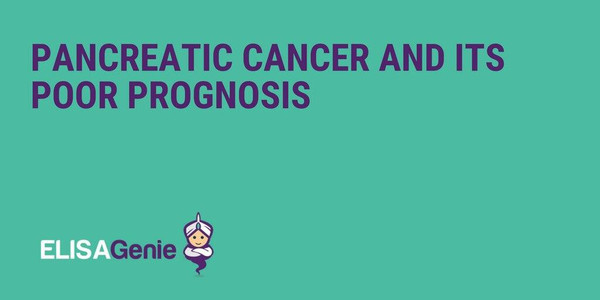Pancreatic Cancer and its Poor Prognosis
Myrna Hurtado, PhD Student, University of North Texas Health Science Center
Advancements in modern medicine have resulted in significantly prolonging and also improving our quality of life. Diseases that were once major afflictions and wiping out vast populations have been almost eradicated. However, these advancements have also led us to realize how much we do not know. It is not improbable to call cancer as the plague of the 21st century. Cancer is a multifactorial disease and arises due to several characteristics acquired from DNA mutations, such as continuous proliferative signaling, resistance to cell death, and invasion and metastasis[1]. 1 in 2 men and 1 in 3 women develop cancer at some point in their lives in the United States alone. It is estimated that the global incidence of cancer will be 15 million by 2020, of which 12 million will result in deaths[2].
Pancreatic Cancer Survival
Despite immense advancements in technology and treatments over the last 40 years, at only 8%, pancreatic cancer (PCa) is one of the few cancers that has failed to make a significant improve in the overall five-year survival rate [3]. This inevitably fatal disease can attribute its dismal statistic to a number of reasons; the leading cause being the time when a diagnosis is made.
Pancreatic Cancer Detection Methods
Currently, there are no early detection methods or even established biomarkers and a person remains asymptomatic in the initial stages. Thus, a diagnosis is typically made during the late stages; giving the patient a poor prognosis. In addition, since this disease it is quick to progress, by the time PCa is identified the cancerous cells usually have already metastasized. Over 80% of patients do not have respectable surgery as a viable option because of the advanced stage [4]. Standard treatment options include radiation and chemotherapy. Unfortunately, this course of treatment remains ineffective as the altered pathways in PCa usually acquire resistance[5, 6]. Furthermore, PCa typically creates a microenvironment for the cancer cells that adds to the resistance to chemo as well as protecting the tumor from immune cells [7]. Due to the high level of toxicity, increasing the radiation or chemotherapy dosages is not a feasible option. Thus, there is a pressing need to identify novel agents that are both effective and non-toxic for PCa. What is currently known about the pathways involved in the formation and progression in PCa is quite limited. It is important to elucidate the dysregulated signaling pathways and mechanisms that occur in PCa to help identify potential biomarkers and targets for treatment.
Sp1 and Survivin as Potential Cancer Targets
Scientists are constantly searching for novel targets for cancer therapy whether it be specific genes or mutations that contribute to the uncontrollable cell proliferation or by targeting cell survival pathways. A large area of interest in cancer research is aberrantly regulated transcription factors. Transcription factors are sequence specific DNA binding proteins involved in initiation and regulation of gene transcription. Transcription factors bind to promoter regions and can modify gene expression using a variety of different mechanisms[8]. In cancer, transcription factors have often been found to be deregulated and contribute to tumorigenesis. Thus, this makes them a potential therapeutic target for cancer. One specific transcription factor of interest is specificity protein 1 (Sp1). Sp1 is a member of the zinc finger Sp family of transcription factors which bind to several different genes containing GC boxes in their promoter elements[9]. Sp1 has been found to be overexpressed in a variety of different cancers, including pancreatic. This overexpression has been found to correlate with metastasis and overall poor patient survival. Because of these findings, it has even been proposed as a possible biomarker for a subdivision of aggressive pancreatic ductal adenocarcinoma[10].
Sp1 Functions
Sp1 regulates various biological functions and processes including cell proliferation, survival, and differentiation. Sp1 has also been identified to play an important role in tumor development, angiogenesis, and metastasis. One gene in particular regulated by Sp1 that contributes to tumorigenesis is survivin. Survivin is a member of the inhibitor of apoptosis protein (IAP) family and is known to have a role in cell cycle regulation and inhibition of apoptosis. Survivin is not ordinarily expressed in adult cells but its overexpression has been found in a variety of different cancers, including pancreatic. Similar to Sp1, survivin is also a negative prognostic factor for patient survival. Survivin has been discovered to contribute to the resistance of tumor cells to chemotherapy and radiation, making treatment more challenging[11, 12]. Because of their involvement in tumor growth and progression, both Sp1 and survivin serve as attractive potential targets in pancreatic cancer treatment. By targeting Sp1, Sp1-dependent survivin expression could potentially be modulated as well.
Clotam’s Anticancer Properties
Nonsteroidal anti-inflammatory drugs (NSAIDs) have gained increasing popularity in studies as chemopreventive and chemotherapeutic agents[13-16]. However, there are limitations to using NSAIDs for cancer therapy because of complications associated with long-term use of COX inhibitors, such as gastrointestinal issues or increased incidence of cardiovascular events[17-20]. Therefore, there has been a rising interest in finding NSAIDs that work in mechanisms independent of COX inhibition. Clotam (tolfenamic acid) is a generic migraine medicine sold in Europe that has been found to contain anticancer properties, such as inhibition of cell growth and induction of apoptosis. Clotam gained interest in our lab because it has been found to not only contain a lower level of toxicity in comparison to other NSAIDs, but also to work in a COX-independent mechanism. Our lab and others have shown that Clotam works through downregulation of Sp1 and survivin in preclinical studies for a variety of cancers, including pancreatic[21-26]. Clotam has also been demonstrated to sensitize cancer cells to radiation treatment in PCa models due to downregulation of Sp1 and survivin[27]. Using Clotam alongside standard care could potentially sensitize PCa cells to treatment, which would result in allowing the patient to receive decreased dosages of cytotoxic therapies.
Novel Derivative of Clotam
Unfortunately, because the dosage for Clotam’s anticancer activity is slightly high, strategies to enhance its efficacy is important. Thus we began looking at various strategies and derivatives to achieve this. Metallodrugs are metal containing drugs and that are currently a very active field of research. They serve as potential novel anticancer agents as these complexes optimize the parent drugs bioactivity through structural modification and inclusion of metals. Interestingly, a novel metal-Clotam compound has been synthesized and reported to contain a higher therapeutic efficacy in comparison to Clotam[28]. Although, its anticancer properties has yet to be investigated in gastro-intestinal cancers. In our study, PCa models were used to assess the anticancer activity of this metal complex of Clotam. Thus far it seems that the metal containing complex has an enhanced efficacy in comparison to Clotam. There is an inhibition of PCa cell growth, downregulation of Sp1 and survivin, and induction of apoptosis with treatment of metal complex of Clotam and at lower doses than Clotam (Clotam’s IC50 value is about twice as high). Pathway analysis to elucidate the underlying mechanisms of this derivative’s anticancer activity is currently under investigation. Further testing is needed to potentially use this as a therapeutic for pancreatic cancer.
References
- Fouad, Y.A. and C. Aanei, Revisiting the hallmarks of cancer. Am J Cancer Res, 2017. 7(5): p. 1016-1036.
- Langley, R.R. and I.J. Fidler, The seed and soil hypothesis revisited–the role of tumor-stroma interactions in metastasis to different organs. Int J Cancer, 2011. 128(11): p. 2527-35.
- Siegel, R.L., K.D. Miller, and A. Jemal, Cancer Statistics, 2017. CA Cancer Journal Clinicians, 2017. 67(1): p. 7-30.
- Hidalgo, M., et al., Addressing the challenges of pancreatic cancer: future directions for improving outcomes. Pancreatology, 2015. 15(1): p. 8-18.
- Oberstein, P.E. and K.P. Olive, Pancreatic cancer: why is it so hard to treat? Therap Adv Gastroenterol, 2013. 6(4): p. 321-37.
- Binenbaum, Y., S. Na’ara, and Z. Gil, Gemcitabine resistance in pancreatic ductal adenocarcinoma. Drug Resist Updat, 2015. 23: p. 55-68.
- Haqq, J., et al., Pancreatic stellate cells and pancreas cancer: current perspectives and future strategies. Eur J Cancer, 2014. 50(15): p. 2570-82.
- Rad, S.M., et al., Transcription factor decoy: a pre-transcriptional approach for gene downregulation purpose in cancer. Tumour Biol, 2015. 36(7): p. 4871-81.
- Beishline, K. and J. Azizkhan-Clifford, Sp1 and the ‘hallmarks of cancer’. FEBS J, 2015. 282(2): p. 224-58.
- Jiang, N.Y., et al., Sp1, a new biomarker that identifies a subset of aggressive pancreatic ductal adenocarcinoma. Cancer Epidemiol Biomarkers Prev, 2008. 17(7): p. 1648-52.
- Sarela, A.I., et al., Expression of survivin, a novel inhibitor of apoptosis and cell cycle regulatory protein, in pancreatic adenocarcinoma. Br J Cancer, 2002. 86(6): p. 886-92.
- Liu, B.B. and W.H. Wang, Survivin and pancreatic cancer. World J Clin Oncol, 2011. 2(3): p. 164-8.
- Basha, R., et al., Therapeutic applications of NSAIDS in cancer: special emphasis on tolfenamic acid. Front Biosci (Schol Ed), 2011. 3: p. 797-805.
- Keller, J.J. and F.M. Giardiello, Chemoprevention strategies using NSAIDs and COX-2 inhibitors. Cancer Biol Ther, 2003. 2(4 Suppl 1): p. S140-9.
- Rao, C.V. and B.S. Reddy, NSAIDs and chemoprevention. Curr Cancer Drug Targets, 2004. 4(1): p. 29-42.
- Hilovska, L., R. Jendzelovsky, and P. Fedorocko, Potency of non-steroidal anti-inflammatory drugs in chemotherapy. Mol Clin Oncol, 2015. 3(1): p. 3-12.
- Gurpinar, E., W.E. Grizzle, and G.A. Piazza, COX-Independent Mechanisms of Cancer Chemoprevention by Anti-Inflammatory Drugs. Front Oncol, 2013. 3: p. 181.
- Wong, M., P. Chowienczyk, and B. Kirkham, Cardiovascular issues of COX-2 inhibitors and NSAIDs. Aust Fam Physician, 2005. 34(11): p. 945-8.
- Martinez-Gonzalez, J. and L. Badimon, Mechanisms underlying the cardiovascular effects of COX-inhibition: benefits and risks. Curr Pharm Des, 2007. 13(22): p. 2215-27.
- Zemmel, M.H., The role of COX-2 inhibitors in the perioperative setting: efficacy and safety–a systematic review. AANA J, 2006. 74(1): p. 49-60.
- Abdelrahim, M., et al., Tolfenamic acid and pancreatic cancer growth, angiogenesis, and Sp protein degradation. J Natl Cancer Inst, 2006. 98(12): p. 855-68.
- Colon, J., et al., Tolfenamic acid decreases c-Met expression through Sp proteins degradation and inhibits lung cancer cells growth and tumor formation in orthotopic mice. Invest New Drugs, 2011. 29(1): p. 41-51.
- Kim, H.J., et al., Apoptotic effect of tolfenamic acid on MDA-MB-231 breast cancer cells and xenograft tumors. J Clin Biochem Nutr, 2013. 53(1): p. 21-6.
- Pathi, S., X. Li, and S. Safe, Tolfenamic acid inhibits colon cancer cell and tumor growth and induces degradation of specificity protein (Sp) transcription factors. Mol Carcinog, 2014. 53 Suppl 1: p. E53-61.
- Sankpal, U.T., et al., Cellular and organismal toxicity of the anti-cancer small molecule, tolfenamic acid: a pre-clinical evaluation. Cell Physiol Biochem, 2013. 32(3): p. 675-86.
- Sankpal, U.T., et al., Tolfenamic acid-induced alterations in genes and pathways in pancreatic cancer cells. Oncotarget, 2017. 8(9): p. 14593-14603.
- Konduri, S., et al., Tolfenamic acid enhances pancreatic cancer cell and tumor response to radiation therapy by inhibiting survivin protein expression. Mol Cancer Ther, 2009. 8(3): p. 533-42.
- Tarushi, A., et al., Copper(II) complexes with the non-steroidal anti-inflammatory drug tolfenamic acid: Structure and biological features. J Inorg Biochem, 2015. 149: p. 68-79.

Recent Posts
-
Exhibition at the University of Oxford's BioEscalator
Showcasing Innovation Assay Genie recently took part in an engaging event at Oxfo …10th Jul 2025 -
Department of Oncology Retreat 2025
Department of Oncology RetreatAssay Genie was honoured to sponsor and participate in t …30th May 2025 -
Cure CLCN4 2025
Cure CLCN4 2025Assay Genie was honored to attend and present at the 2025 Cure CLCN4 Sc …26th May 2025




